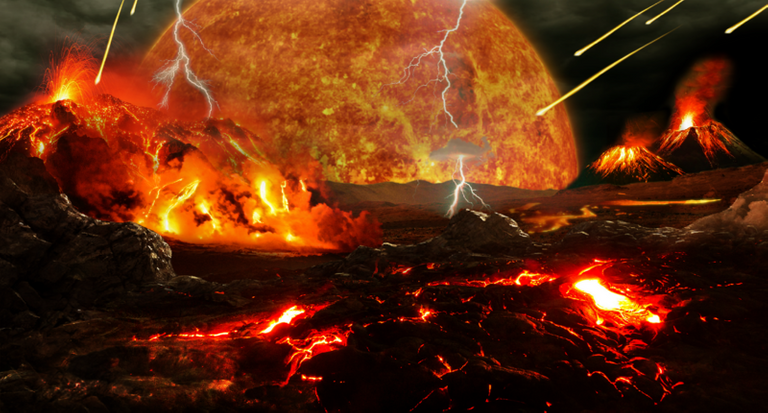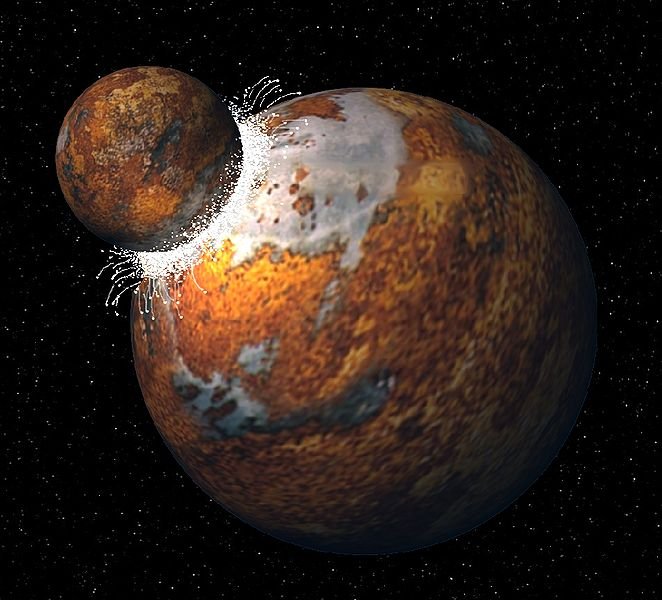
The creation of the Solar System contributed to the creation of our present day home, the Earth. At that time, Earth differed little from other objects of its type, and it began to change when the Moon appeared. For many years, several hypotheses about the origin of the moon have been put forward. These hypotheses spoke, among other, of the separation of the earth into two separate bodies during its creation, as well as the interception of the moon by the Earth's orbit. It was not until Apollo's mission and the resulting study of lunar rocks that the most probable theory about the appearance of our silver satellite were possible. This hypothesis is called the giant-impact and is still valid today. According to it, the Moon was created as a result of a collision between the young Earth and a planet the size of Mars placed in the same orbit, called Theia, less often Orpheus.
The planetary impact has thrown huge amounts of earth into orbit. Some of them fell on it with time, but many fragments began to combine in orbit and over the years they merged into the Moon.
After this incident the Earth did not resemble this from today, it was more like a sphere of lava. Millions of years lasted before the lava gradually dried up to form a black shell on its surface. If we had the opportunity to observe our planet at that time, we would surely see a black planet crisscrossed with cracks filled with lava. The atmosphere did not contain oxygen in exchange for large amounts of sulfur, and this situation turned when the water began to appear.
One of the most solid hypothesis about the appearance of water on Earth say that is has appeared due to the bombarding planet asteriods. Elements such as hydrogen and oxygen have been blown out by the solar wind created by the formation of the Solar system. These elements began to build small celestial bodies, which were influenced, by the gravity and for example turned in to direction of Earth. At the beginning of the Earth's existence, a lot of them hit it containing the amount of water. This hypothesis, however, has inaccuracies because of the mission Rosetta which was carried out in 2014. It task was to enter into orbit around the nucleus of comet 67P / Churyumov-Gerasimenko which is connected to the family of comets influenced Earth in Hadean.
Studies have shown that discovered water has a different chemical composition than that present on Earth. To this day we do not know the exactly origin of water, but we have information about its composition. The ocean of this period could have reached the temperature of even 100 degrees of Celsius. It was also twice as saline and plentiful in huge storms. The image of the black earth I described earlier could now be seen as an ocean-covered shell with local flashes of black islands. With time, the first continents began to emerge.
At the end of the Hadean era and the beginning of Archean, perhaps one of the most important events for us as humanity took place. Life began to appear.
References:
[1] http://www.iopan.gda.pl/~piskozub/klimat/Klimat-wyklad2010-01.pdf
[2] http://www.home.umk.pl/~kmgesicki/wyklad_AF1_05.pdf
[3] http://invertebrates.uni.lodz.pl/wp-content/uploads/wyklad_Historia%20biosfery%20I.pdf

There's evidence to suggest the Earth formed with plenty of water already: https://news.nationalgeographic.com/news/2014/10/141030-starstruck-earth-water-origin-vesta-science/
Yes you are right. There is the hypothesis of the biochemical reaction of the Earth's surface. There are assumptions that instead of emitting water, it was absorbed by it's surface.